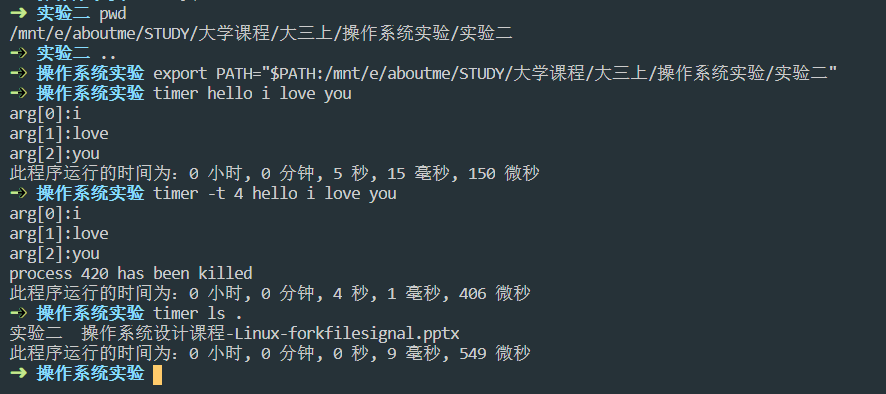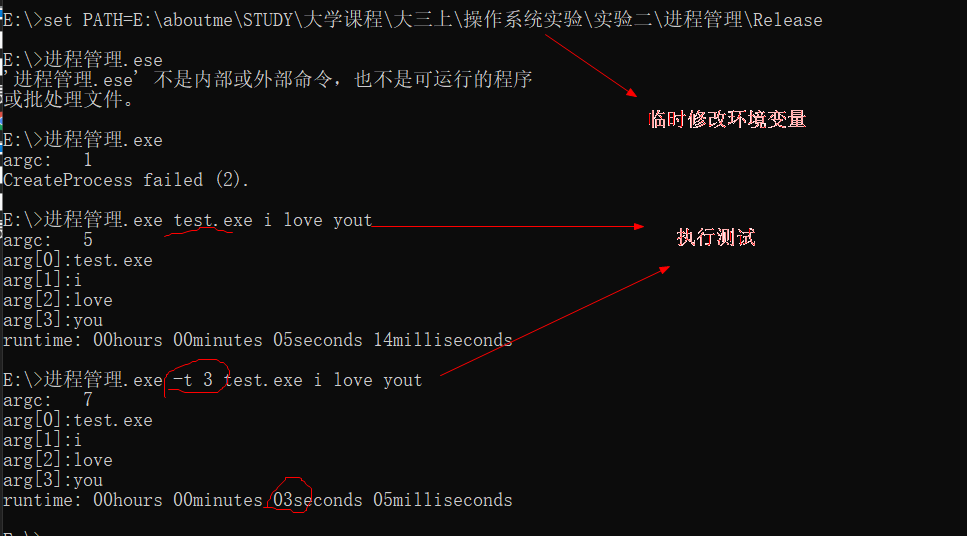linux與Windows程序控制
程序管理控制
這裡實現的是一個自定義timer用於統計子程序執行的時間。使用方式主要是
timer [-t seconds] command arguments例如要統計ls的執行時間可以直接輸入timer ls,其後的arguments是指所要執行的程式的引數。如:timer ls -al。如果要指定程式執行多少時間,如5秒鐘,可以輸入timer -t 5 ls -al。需要注意的是,該程式對輸入沒有做異常檢測,所以要確保程式輸入正確。
Linux
程式思路
獲取時間
時間獲取函式使用
gettimeofday,精度可以達到微秒struct timeval{ long tv_sec;*//秒* long tv_usec;*//微秒* }子程序建立
fork()函式#include <sys/types.h> #include <unistd.h> pid_t fork(void);fork呼叫失敗則返回-1,呼叫成功則:fork函式會有兩種返回值,一是為0,一是為正整數。若為0,則說明當前程序為子程序;若為正整數,則該程序為父程序且該值為子程序pid。關於程序控制的詳細說明請參考:程序控制
exec函式用fork建立子程序後執行的是和父程序相同的程式(但有可能執行不同的程式碼分支),子程序往往要呼叫一種exec函式以執行另一個程式。當程序呼叫一種exec函式時,該程序的使用者空間程式碼和資料完全被新程式替換,從新程式的啟動例程開始執行。呼叫exec並不建立新程序,所以呼叫exec前後該程序的id並未改變。
其實有六種以exec開頭的函式,統稱exec函式:#include <unistd.h> int execl(const char *path, const char *arg, ...); int execlp(const char *file, const char *arg, ...); int execle(const char *path, const char *arg, ..., char *const envp[]); int execv(const char *path, char *const argv[]); int execvp(const char *file, char *const argv[]); int execve(const char *path, char *const argv[], char *const envp[]);這些函式如果呼叫成功則載入新的程式從啟動程式碼開始執行,不再返回,如果調用出錯則返回-1,所以exec函式只有出錯的返回值而沒有成功的返回值。
wait與waitpid一個程序在終止時會關閉所有檔案描述符,釋放在使用者空間分配的記憶體,但它的PCB還保留著,核心在其中儲存了一些資訊:如果是正常終止則儲存著退出狀態,如果是異常終止則儲存著導致該程序終止的訊號是哪個。這個程序的父程序可以呼叫wait或waitpid獲取這些資訊,然後徹底清除掉這個程序。我們知道一個程序的退出狀態可以在Shell中用特殊變數$?檢視,因為Shell是它的父程序,當它終止時Shell呼叫wait或waitpid得到它的退出狀態同時徹底清除掉這個程序。
如果一個程序已經終止,但是它的父程序尚未呼叫wait或waitpid對它進行清理,這時的程序狀態稱為殭屍(Zombie)程序。任何程序在剛終止時都是殭屍程序,正常情況下,殭屍程序都立刻被父程序清理了。
殭屍程序是不能用kill命令清除掉的,因為kill命令只是用來終止程序的,而殭屍程序已經終止了。
#include <sys/types.h> #include <sys/wait.h> pid_t wait(int *status); pid_t waitpid(pid_t pid, int *status, int options);若呼叫成功則返回清理掉的子程序id,若調用出錯則返回-1。父程序呼叫wait或waitpid時可能會:
阻塞(如果它的所有子程序都還在執行
- 帶子程序的終止資訊立即返回(如果一個子程序已終止,正等待父程序讀取其終止資訊)
出錯立即返回(如果它沒有任何子程序)
這兩個函式的區別是:
- 如果父程序的所有子程序都還在執行,呼叫wait將使父程序阻塞,而呼叫waitpid時如果在options引數中指定WNOHANG可以使父程序不阻塞而立即返回0
- wait等待第一個終止的子程序,而waitpid可以通過pid引數指定等待哪一個子程序
原始碼
timer原始碼
#include <math.h>
#include <stdio.h>
#include <stdlib.h>
#include <sys/time.h>
#include <unistd.h>
#include <wait.h>
#include <ctime>
#include <iostream>
#include <cstring>
//程式假定輸入完全正確,沒有做異常處理
//mytime [-t number] 程式
using namespace std;
//呼叫系統時間
struct timeval time_start;
struct timeval time_end;
void printTime();
void newProcess(const char *child_process, char *argv[], double duration);
int main(int argc, char const *argv[])
{
double duration = 0;
char **arg;
int step = 2;
if (argc > 3 && (strcmp((char *)"-t", argv[1]) == 0)) //如果指定了執行時間
{
step = 4;
duration = atof(argv[2]); //沒有做異常處理
}
arg = new char *[argc - step + 1];
for (int i = 0; i < argc - step; i++)
{
arg[i] = new char[100];
strcpy(arg[i], argv[i + step]);
}
arg[argc - step] = NULL;
newProcess(argv[step - 1], arg, duration);
return 0;
}
void printTime()
{
//用以記錄程序執行的時間
int time_use = 0; // us
int time_left = 0; // us
int time_hour = 0, time_min = 0, time_sec = 0, time_ms = 0, time_us = 0;
gettimeofday(&time_end, NULL);
time_use = (time_end.tv_sec - time_start.tv_sec) * 1000000 + (time_end.tv_usec - time_start.tv_usec);
time_hour = time_use / (60 * 60 * (int)pow(10, 6));
time_left = time_use % (60 * 60 * (int)pow(10, 6));
time_min = time_left / (60 * (int)pow(10, 6));
time_left %= (60 * (int)pow(10, 6));
time_sec = time_left / ((int)pow(10, 6));
time_left %= ((int)pow(10, 6));
time_ms = time_left / 1000;
time_left %= 1000;
time_us = time_left;
printf("此程式執行的時間為:%d 小時, %d 分鐘, %d 秒, %d 毫秒, %d 微秒\n", time_hour, time_min, time_sec, time_ms, time_us);
}
void newProcess(const char* child_process, char **argv, double duration)
{
pid_t pid = fork();
if (pid < 0) //出錯
{
printf("建立子程序失敗!");
exit(1);
}
if (pid == 0) //子程序
{
execvp(child_process, argv);
}
else
{
if (abs(duration - 0) < 1e-6)
{
gettimeofday(&time_start, NULL);
wait(NULL); //等待子程序結束
printTime();
}
else
{
gettimeofday(&time_start, NULL);
// printf("sleep: %lf\n", duration);
waitpid(pid, NULL, WNOHANG);
usleep(duration * 1000000); // sec to usec
int kill_ret_val = kill(pid, SIGKILL);
if (kill_ret_val == -1) // return -1, fail
{
printf("kill failed.\n");
perror("kill");
}
else if (kill_ret_val == 0) // return 0, success
{
printf("process %d has been killed\n", pid);
}
printTime();
}
}
}測試原始碼
#include <iostream>
#include <ctime>
#include <unistd.h>
using namespace std;
int main(int argc, char const *argv[])
{
for(int n = 0; n < argc; n++)
{
printf("arg[%d]:%s\n",n, argv[n]);
}
sleep(5);
return 0;
}測試
自行編寫程式測試

系統程式測試

將timer加入環境變數
這裡僅進行了臨時變數修改。

Windows
在Windows下進行父子程序的建立和管理在api呼叫上相較Linux有一定難度,但實際上在使用管理上比Linux容易的多。
CreateProcess
#include <Windows.h>
BOOL CreateProcessA(
LPCSTR lpApplicationName,
LPSTR lpCommandLine,
LPSECURITY_ATTRIBUTES lpProcessAttributes,
LPSECURITY_ATTRIBUTES lpThreadAttributes,
BOOL bInheritHandles,
DWORD dwCreationFlags,
LPVOID lpEnvironment,
LPCSTR lpCurrentDirectory,
LPSTARTUPINFOA lpStartupInfo,
LPPROCESS_INFORMATION lpProcessInformation
);原始碼實現
timer程式
// 程序管理.cpp : 此檔案包含 "main" 函式。程式執行將在此處開始並結束。
//
#include <iostream>
#include <wchar.h>
#include <Windows.h>
#include <tchar.h>
using namespace std;
void printTime(SYSTEMTIME* start, SYSTEMTIME* end);
void newProcess(TCHAR* cWinDir, double duration);
int _tmain(int argc, TCHAR *argv[])
{
TCHAR* cWinDir = new TCHAR[MAX_PATH];
memset(cWinDir, sizeof(TCHAR) * MAX_PATH, 0);
printf("argc: %d\n", argc);
int step = 1;
double duration = 0;
if (argc > 1)
{
if (argv[1][0] == TCHAR('-') && argv[1][1] == TCHAR('t') && argv[1][2] == TCHAR('\0'))
{
step = 3;
duration = atof((char*)argv[2]);
}
}
//printf("printf content start: %ls\n", argv[1]);
int j = 0;
for (int i = 0, h = 0; i < argc - step; i++)
{
wcscpy_s(cWinDir + j, MAX_PATH - j, argv[i + step]);
for (h = 0; argv[i + step][h] != TCHAR('\0'); h++);
j += h;
cWinDir[j++] = ' ';
//printf("%d : %d\n", i, j);
//printf("printf content start: %ls\n", cWinDir);
}
cWinDir[j - 2] = TCHAR('\0');
//printf("printf content start: %ls\n", cWinDir);
newProcess(cWinDir,duration);
return 0;
}
void printTime(SYSTEMTIME* start, SYSTEMTIME* end)
{
int hours = end->wHour - start->wHour;
int minutes = end->wMinute - start->wMinute;
int seconds = end->wSecond - start->wSecond;
int ms = end->wMilliseconds - start->wMilliseconds;
if (ms < 0)
{
ms += 1000;
seconds -= 1;
}
if (seconds < 0)
{
seconds += 60;
minutes -= 1;
}
if (minutes < 0)
{
minutes += 60;
hours -= 1;
}
//由於僅考慮在一天之內,不考慮小時會變成負數的情況
printf("runtime: %02dhours %02dminutes %02dseconds %02dmilliseconds\n", hours, minutes, seconds, ms);
}
void newProcess(TCHAR* cWinDir, double duration)
{
PROCESS_INFORMATION pi;
STARTUPINFO si;
ZeroMemory(&si, sizeof(si));
si.cb = sizeof(si);
ZeroMemory(&pi, sizeof(pi));
SYSTEMTIME start_time, end_time;
memset(&start_time, sizeof(SYSTEMTIME), 0);
memset(&end_time, sizeof(SYSTEMTIME), 0);
GetSystemTime(&start_time);
if (CreateProcess(
NULL, //lpApplicationName.若為空,則lpCommandLine必須指定可執行程式
//若路徑中存在空格,必須使用引號框定
cWinDir, //lpCommandLine
//若lpApplicationName為空,lpCommandLine長度不超過MAX_PATH
NULL, //指向一個SECURITY_ATTRIBUTES結構體,這個結構體決定是否返回的控制代碼可以被子程序繼承,程序安全性
NULL, // 如果lpProcessAttributes引數為空(NULL),那麼控制代碼不能被繼承。<同上>,執行緒安全性
false, // 指示新程序是否從呼叫程序處繼承了控制代碼。控制代碼可繼承性
0, // 指定附加的、用來控制優先類和程序的建立的識別符號(優先順序)
// CREATE_NEW_CONSOLE 新控制檯開啟子程序
// CREATE_SUSPENDED 子程序建立後掛起,直到呼叫ResumeThread函式
NULL, // 指向一個新程序的環境塊。如果此引數為空,新程序使用呼叫程序的環境。指向環境字串
NULL, // 指定子程序的工作路徑
&si, // 決定新程序的主窗體如何顯示的STARTUPINFO結構體
&pi // 接收新程序的識別資訊的PROCESS_INFORMATION結構體。程序執行緒以及控制代碼
))
{
}
else
{
printf("CreateProcess failed (%d).\n", GetLastError());
return;
}
//wait untill the child process exits
if (abs(duration - 0) < 1e-6)
WaitForSingleObject(pi.hProcess, INFINITE);//這裡指定執行時間,單位毫秒
else
WaitForSingleObject(pi.hProcess, duration * 1000);
GetSystemTime(&end_time);
printTime(&start_time, &end_time);
CloseHandle(pi.hProcess);
CloseHandle(pi.hThread);
}測試程式
#include <iostream>
#include <Windows.h>
using namespace std;
int main(int argc, char* argv[])
{
for (int n = 0; n < argc; n++)
{
printf("arg[%d]:%s\n", n, argv[n]);
}
Sleep(5*1000);
return 0;
}測試
自行編寫程式測試

系統程式測試

新增至環境變數

參考資料
Windows
- CreateProcess
Linux
程序控制
程序控制,linux環境
Linux父程序建立子程序的方法
Linux建立子程序執行任務
execv Linux man page
execv函式的應用
